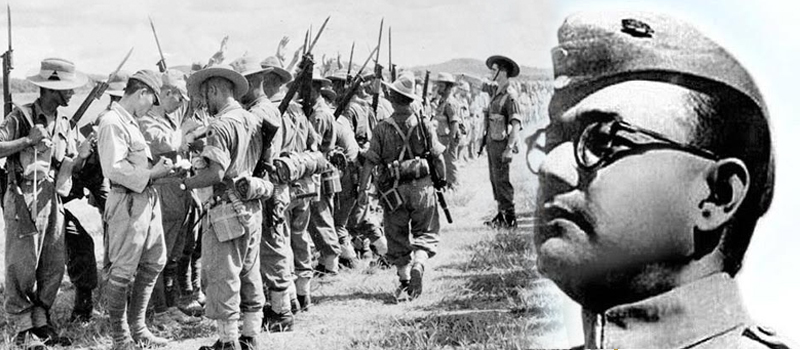Formation of Azad Hind Fauj: A Milestone in India's Struggle for Independence
History Indian HistoryPosted by NewAdmin on 2025-02-13 08:44:38 |
Share: Facebook | Twitter | Whatsapp | Linkedin Visits: 11

The Azad Hind Fauj, also known as the Indian National Army (INA), was formally established on September 1, 1942, with the aim of securing India’s independence from British rule through armed struggle. The idea of forming such an army emerged among Indian soldiers and nationalists who were captured or living in Japanese-occupied territories during World War II. The initiative was first taken by Mohan Singh, an officer in the British Indian Army who was captured by Japanese forces in Malaya. With Japanese encouragement, he began recruiting Indian prisoners of war to form an army that would fight against British rule.
The initial structure of the INA, however, faced setbacks due to internal conflicts and lack of strong leadership. The movement gained momentum when Subhas Chandra Bose, a prominent nationalist leader, took charge of the INA in 1943. Bose had escaped from British-occupied India and reached Japan, where he sought support to lead an armed struggle against the British. Under his leadership, the INA was restructured and strengthened, with a clearer vision and strategy.
Bose’s leadership transformed the INA into a disciplined and organized military force. He gave the army the slogan "Jai Hind" and inspired soldiers with the call "Give me blood, and I will give you freedom." The INA was composed of Indian prisoners of war, civilians, and volunteers from Southeast Asia, particularly from Malaya, Burma, and Singapore. The army had different units, including the Rani of Jhansi Regiment, which was an all-women combat unit led by Captain Lakshmi Sahgal.
The INA collaborated with the Japanese army and launched military campaigns in India, particularly in the northeastern regions of Manipur and Nagaland. It participated in the battles of Imphal and Kohima in 1944, but due to logistical difficulties, harsh weather, and lack of adequate support, these campaigns did not succeed. The eventual surrender of Japan in 1945 marked the decline of the INA as it lost its backing and resources.
Although the INA did not achieve its goal of directly overthrowing British rule, it played a significant role in India’s independence movement. The trials of INA soldiers at the Red Fort in Delhi created widespread nationalist sentiments and led to mass protests across India. The movement also exposed the weaknesses of British rule and contributed to the growing demand for independence, which was eventually achieved in 1947. The formation of the Azad Hind Fauj remains a key milestone in India’s struggle for freedom, symbolizing courage, unity, and the desire for self-rule.
Search
Categories
- Sports
- Business
- History
- Politics
- International
- Science & Technology
- Social Issues
- Disaster Management
- Current Affairs
- Education
- Startup Business
- Startup News
- Awards
- Community Services
- Fundraising Events
- Volunteer Services
- Health Initiatives
- Innovations and Initiatives
- In News
- dummybanners
- Awards
- Partners
- Products
- Press Releases
- News
- Fast Check
- South
- సినిమా
- Gallery
- Sunday Chronicle
- Hyderabad Chronicle
- లైఫ్ స్టైల్
- National
- క్రైం
- ట్రెండింగ్
- జాబ్స్
- అంతర్జాతీయo
- బిజినెస్
- రాజకీయం
- బిజినెస్
- సంపాదకీయం
- నవ్య
- చిత్ర జ్యోతి
- క్రీడలు
- జాతీయం
- తెలంగాణ
- తాజా వార్తలు
- మన పార్టీ
- మన నాయకత్వం
- మన విజయాలు
- డౌన్లోడ్స్
- మీడియా వనరులు
- కార్యకర్తలు
- North East Skill Center News
- Government Schemes
- Entrepreneurship Support
- Employment Opportunities
- Skill Training Programs
- Departments
- Investments
- Initiatives
- Resources
- Telangana IT Parks
- Events & Jobs
- Press Releases
- News
- Airport News
- Newtons Laws of Motion
- Karbonn in Business
- Investments in Karbonn
- Company quarterly sales
- Markets
- Auto News
- Industry
- Money
- Advertisements
- Stock target
- Company Updates
- Stock Market
- Company Sales
- Staffing and HR
- Constituency Assembly
- General News
- Srikalahasti Temple
- Bojjala Sudhir Reddy
- Technology & Innovation
- Sports
- Business
- Products
- Industries
- Services & Trainings
- Tools & Resources
- Technology Integration
- Drug Seizures & Arrests
- Telangana Narcotics
- Law & Enforcement
- Rehabilitation
- Nationwide Drug Policing
- Nigeria Seizures
- Global Operations
- Drug Awareness
- Drug Enforcement Tech
- NCB Drug Seizures
- Judicial Crackdown
- India's Surveillance Tools
- Cross-Border Links
- Women Safety
- Cyber Crimes
- Drug Abuse
- Traffic & Road Safety
- Community Connect
- Public Safety Alerts
- Citizen Assistance
- Nellore City News
- Politics & Administration
- Events & Festivals
- Agriculture & Rural
- Business & Economy
- Health & Wellness
Recent News
- Former Vice President Jagdeep Dhankhar Not Yet Requested Official Residence Retainment
- Mopping Up Operations In Lok Sabha, Speaker Om Birla Calls For Introspection
- Last-minute disruptions mark final day of parliament's monsoon session
- Market regulator SEBI plans to extend equity derivatives tenure
- Stock Picks for February: YES Securities & Sharekhan Optimistic About These 5 Companies
- Ban On Real-Money Gaming: 45 Million People Lose Rs 20,000 Crore Each Year, Says Report
- From Porn To Cricket: How Garth Stirrat Rebounds From An Unorthodox Start
- Rift In Saaniya Chandhok's Family? Grandfather Accuses Son of Forgery And Fraud